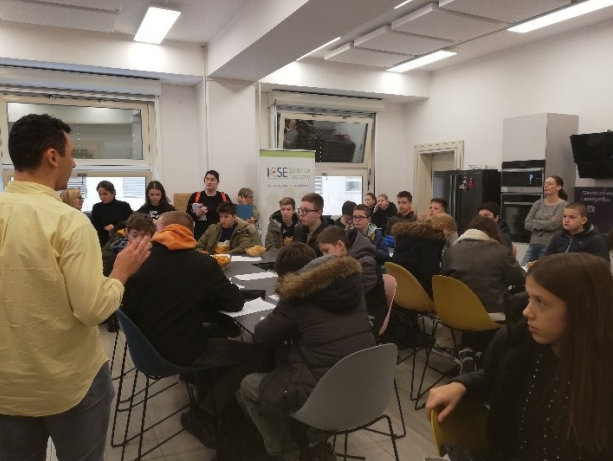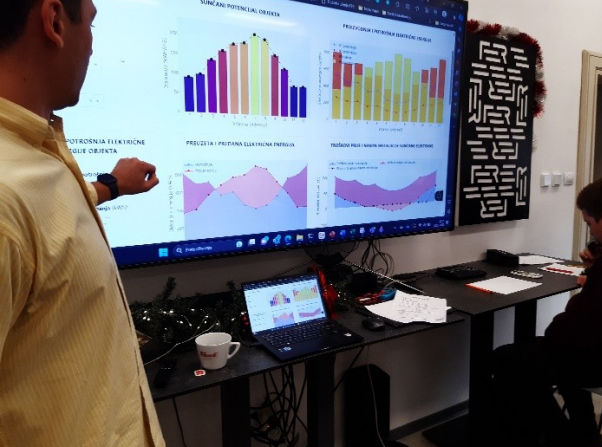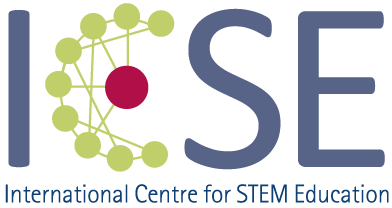Basic Information
- Interdisciplinarity: Mathematics, Physics, Computing, and Energetics
- Duration: 90 minutes
- Target Age of Participants: 13 and 14 years old
- Partners Involved in the Activity: Croatian Mathematics Society (HMD) and Faculty of Electrical Engineering and Computing Zagreb (FER)
Description of the Activity
The main aim of the Lighthouse activity “Modern Energy in Households” is for participants to:
- Learn (or revise their knowledge of) basic concepts related to power systems.
- Get introduced to different electricity tariff models existing in Croatia and consider the benefits of these models for households.
- Understand the necessity of balancing power production and consumption.
- Explore power consumption of different devices in DRLab (Energy Demand Response Laboratory).
- Assess the benefits and costs of household solar systems through the solar calculator web application developed by FER.
- Reflect on the role of energy in everyday life and the importance of responsible power consumption.
The activity primarily covers topics related to the environment and the Green Deal, while also including aspects of digitalization. Participants were challenged with various problems requiring computation and basic physics concepts.
Course of the Activity
Participants first go through a short introduction to DRLab, including the purpose of the lab and how to use it. DRLab is a room equipped with numerous kitchen and household devices (e.g., oven, microwave oven, coffee machine, water heater, washing machine, dryer, vacuum cleaner, lighting system, floor heating system). The lab also features a display that records the electricity consumption of each individual device.
After the introduction, participants review or acquire knowledge about basic concepts regarding power and power systems (e.g., electricity, voltage, appropriate measurement units, existing tariff models). Next, participants engage in problem-solving activities. Problems are solved independently or collaboratively, with assistance available from the activity leader if needed. Once the solutions are verified, the activity continues with the consumption analysis of live-measured electrical devices from DRLab.
In this part of the activity, various devices are switched on while their consumption is monitored on the display. Before each experiment, participants are asked to estimate the consumption of each device. With the real data obtained, participants calculate the total electricity consumption and the associated cost (e.g., for baking a strudel).
The Lighthouse activity ends with a solar calculator demonstration. The web application (https://fnelektrane.pythonanywhere.com/) for calculations related to solar power plants within the self-supply model is demonstrated to the participants. They explore the potential consumption or production of solar energy for a household located, for example, in the Split-Dalmatia County, monitor the costs, and discover the point at which the investment would be returned. The experiment is repeated with different settings, and the results are compared.

Picture: self-recorded by University of Zagreb

Picture: self-recorded by University of Zagreb
Description of Implementation Process
This activity was collaboratively designed by the Department of Energy and Power Systems at the Faculty of Electrical Engineering and Computing and the Croatian Mathematics Society. The activity was conducted in the DRLab, located in the Faculty of Electrical Engineering and Computing building, with a duration of 90 minutes.
The main leader of the activity was M. Eng. Luka Budin, a member of the Department of Energy and Power Systems. His role was to introduce participants to DRLab and coordinate their activities in solving the lesson sheet. Additional support with organization, coordination, logistics, assistance with baking a strudel, and motivating participants for active collaboration was provided by Petra Vidović (HMD), Renata Svedrec (HMD), and Matea Dvoršćak (PMF).
There were 32 active participants in the Lighthouse activity. Most of the participants were 13- or 14-years old, accompanied by one physics teacher. The participants played an active role in the activity. They were encouraged to pose questions, and many questions were raised, such as: “What is the definition of direct current?”, “How can we know what the system voltage is?”, and “Will a larger investment in solar panels yield a faster return on investment?”.
The activity was organized as a series of heuristic conversations with prompting questions such as: “What is the relationship between electricity consumption and its original price?”, “What do we need to calculate the consumption and cost of electricity?”, “Why is using kJ not convenient for displaying electricity consumption, and why do we use kWh?”, and “When will the air conditioner have a higher consumption—if we heat in winter or summer, or if we cool in winter or summer?”. These questions stimulated participants to be active and use their reasoning and justification skills.
Outcomes
In the course of the activity, students will:
- Learn (or revise) concepts related to electricity, voltage, appropriate measurement units, and existing tariff models.
- Practice calculations of consumed electricity, the cost of electricity, and determining current flows.
- Consider the use of appropriate measurement units.
- Practice their graph reading and interpretation skills.
- Reflect on responsible electricity consumption in a household.
- Reflect on the strengths and weaknesses of different energy sources.
- Develop a positive attitude toward the importance of reflecting on responsible electricity consumption.
- Develop positive attitudes toward renewable energy sources (solar energy).
Final Remarks
The power system paradigm has shifted over the last decade, requiring consumers to adopt more responsible electricity usage. Demand response, which involves shifting or reducing electricity consumption when necessary, is now essential. Educating young people about efficient electricity use—both in their households and in broader economic contexts—is crucial.
The Modern Energy in Households Lighthouse initiative contributes significantly to this goal. The collaboration between HMD and FER has been highly productive, with the Department of Energy and Power Systems playing a key role in designing and refining the activity.
To enhance the initiative, limiting group sizes to approximately 20 participants would optimize engagement and space utilization in the DRLab. Extending the activity’s duration would also be beneficial, allowing for deeper discussions and a more comprehensive understanding of responsible energy use. A structured concluding discussion would further reinforce key insights.
This initiative is a well-designed, impactful approach to fostering responsible electricity consumption and should be continued.
